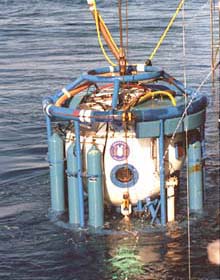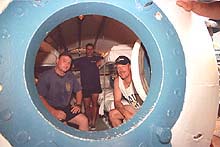
Saturation divers are lowered to the Monitor in a pressurized diving bell. U. S. Navy photo by PHC A. McKaskle. Click image for larger view.

Divers emerge from the saturation chamber after spending a week under pressure, diving on the wreck of the Monitor. U.S. Navy photo by PHC A. McKaskle. Click image for larger view.
U.S. Navy Saturation Diving at the Monitor National Marine Sanctuary
Captain Chris Murray, Supervisor of Diving
Naval Sea Systems Command, U.S. Navy
During the Monitor 2001 Expedition, Navy divers are utilizing the Global Industries 1504 saturation system, a 12-person, two-chamber system with a two-person closed diving bell. The system can operate as deep as 1,500 ft -- considerably deeper than the Monitor, which rests on the sea floor at a depth of 235 ft. Saturation systems are often used in deep-water situations (below 200 ft) in order to reduce the time lost to decompression, the slow ascent to the surface required for preventing decompression sickness, also known as "the bends."
As an example, if a diver worked on the Monitor for one hr, he or she would have to spend an additional five hrs in decompression. A diver working in the saturation mode, however, usually works for 4 hrs, then returns to the bell with no decompression at all. Saturation divers enter a walk-in chamber where they are pressurized to nearly the same pressure they will experience on the intended work site (180 ft in the case of the Monitor). The divers are sealed in the chamber for a week or more, remaining under pressure the entire time, their bodies saturated with gas. They have bunks and sanitation facilities, and food and supplies are sent in, as needed, through a special pressure lock. At the end of their stay, Monitor saturation divers must undergo 66 hrs of decompression -- almost three days!
While in saturation, divers breathe a mixture of oxygen and helium. The mix is designed to prevent pressure-related maladies. An unintended "side effect" is that it will also cause a man with the deepest bass voice to sound like "Donald Duck"!
The system works like this: Four divers are pressurized in one of two steel chambers. When they are ready to dive, two divers enter a diving bell and seal its hatch. The bell is lowered to a depth of 180 ft, where the wreck of the Monitor is usually visible. Gas is added to the bell until the pressure inside equalizes with the pressure outside, at which time the hatch can be opened without water entering the bell. One diver then leaves the bell, while the other stays inside in case an emergency arises. Following the first work period (usually 4 hrs at the Monitor), the two divers exchange places, and the second diver goes to work.After both divers have completed their work cycles, the bell is raised and docked with the deck chamber. The other two divers then take their places in the bell and repeat the cycle.
Sign up for the Ocean Explorer E-mail Update List.






















